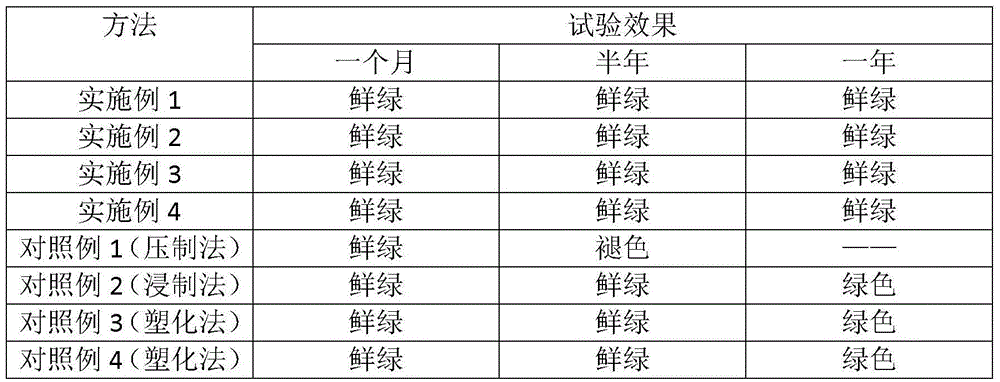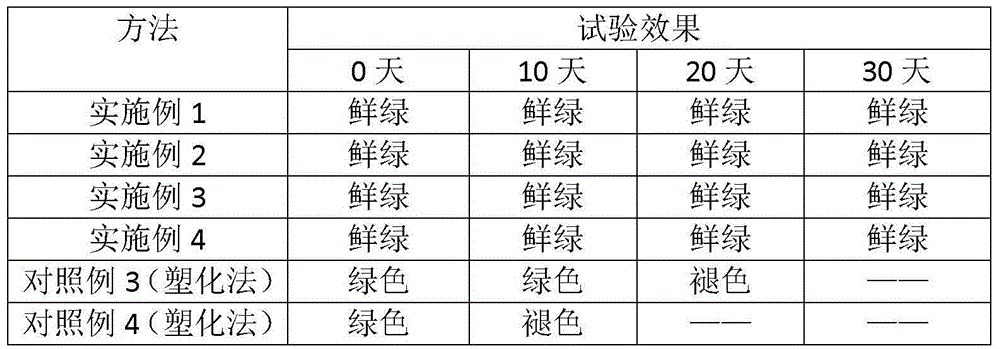Preparation method of plant plasticized specimen
A production method and specimen technology, which are applied in the fields of botany equipment and methods, plant preservation and application, can solve the problems of long plasticization soaking time, long pretreatment time of specimens, in-depth study of plant specimens, etc., and achieve a simple production process. Easy, long-lasting, artistic effects
- Summary
- Abstract
- Description
- Claims
- Application Information
AI Technical Summary
Problems solved by technology
Method used
Image
Examples
Embodiment 1
[0043] Collect Coptis chinensis plants with normal growth and no pests and diseases as specimen materials, and cut off diseased and dead leaves, incomplete flowers and excessive branches and leaves. It is required to preserve the integrity of the plant as much as possible and retain its taxonomic identification characteristics. Wash the collected fresh Coptis chinensis with tap water, soak and rinse with distilled water for 3 times, and arrange the leaves and flowers. Heating the pretreated coptis plants in 10% copper acetate aqueous solution until the plants first turn yellow-green and then green, and then rinse the plants with clear water. Put the color-fixed plants into 10%, 30%, 50%, 70%, and 100% plasticizing solution (PEG-400) for gradient soaking, and the soaking time is 6, 10, 15, 15, and 20 hours respectively . Remove after soaking and rinse off residual solution with clean water. The plasticized specimens were blown and heated at 40°C until the plants were complet...
Embodiment 2
[0045] Collect Coptis chinensis plants with normal growth and no pests and diseases as specimen materials, and cut off diseased and dead leaves, incomplete flowers and excessive branches and leaves. It is required to preserve the integrity of the plant as much as possible and retain its taxonomic identification characteristics. Wash the collected fresh Coptis chinensis with tap water, soak and rinse with distilled water for 3 times, and arrange the leaves and flowers. Heating the pretreated coptis plants in 36% copper acetate aqueous solution until the plants first turn yellow-green and then green, and then rinse the plants with clear water. Put the color-fixed plants into 20%, 40%, 60%, 80%, and 100% plasticizing solution (PEG-400) for gradient soaking, and the soaking time is 8, 10, 12, 12, and 15 hours respectively . Remove after soaking and rinse off residual solution with clean water. The plasticized specimens were blown and heated at 40°C until the plants were complet...
Embodiment 3
[0047] Collect Coptis chinensis plants with normal growth and no pests and diseases as specimen materials, and cut off diseased and dead leaves, incomplete flowers and excessive branches and leaves. It is required to preserve the integrity of the plant as much as possible and retain its taxonomic identification characteristics. Wash the collected fresh Coptis chinensis with tap water, soak and rinse it twice with distilled water, and arrange the leaves and flowers. Heating the pretreated coptis plants in 15% copper acetate aqueous solution until the plants first turn yellow-green and then green, and then rinse the plants with clear water. Put the color-fixed plants into 20%, 40%, 70%, 85%, and 100% plasticizing solution (PEG-500) for gradient soaking, and the soaking time is 6, 12, 16, 16, and 20 hours respectively . Remove after soaking and rinse off residual solution with clean water. The plasticized specimens were blown and heated at 40°C until the plants were completely...
PUM
 Login to View More
Login to View More Abstract
Description
Claims
Application Information
 Login to View More
Login to View More - R&D
- Intellectual Property
- Life Sciences
- Materials
- Tech Scout
- Unparalleled Data Quality
- Higher Quality Content
- 60% Fewer Hallucinations
Browse by: Latest US Patents, China's latest patents, Technical Efficacy Thesaurus, Application Domain, Technology Topic, Popular Technical Reports.
© 2025 PatSnap. All rights reserved.Legal|Privacy policy|Modern Slavery Act Transparency Statement|Sitemap|About US| Contact US: help@patsnap.com


